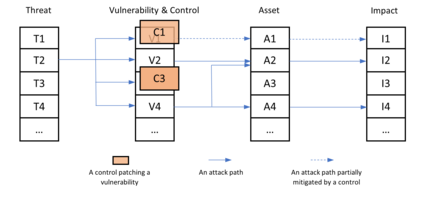Cyber risk is an omnipresent risk in the increasingly digitized world that is known to be difficult to quantify and assess. Despite the fact that cyber risk shows distinct characteristics from conventional risks, most existing models for cyber risk in the insurance literature have been purely based on frequency-severity analysis, which was developed for classical property and casualty risks. In contrast, the cybersecurity engineering literature employs different approaches, under which cyber incidents are viewed as threats or hacker attacks acting on a particular set of vulnerabilities. There appears a gap in cyber risk modeling between engineering and insurance literature. This paper presents a novel model to capture these unique dynamics of cyber risk known from engineering and to model loss distributions based on industry loss data and a particular company's cybersecurity profile. The analysis leads to a new tool for allocating resources of the company between cybersecurity investments and loss-absorbing reserves.
翻译:网络风险在日益数字化的世界中是一种无处不在的风险,众所周知,这种风险难以量化和评估。尽管网络风险显示出与常规风险不同的特点,但保险文献中大多数现有的网络风险模式纯粹基于频率分析,而这种分析是为古典财产和伤亡风险而开发的。相比之下,网络安全工程文献采用不同的做法,将网络事件视为威胁或黑客攻击行为,对特定的一组脆弱性采取行动。在工程和保险文献的网络风险建模方面似乎存在差距。本文提供了一个新的模型,用以捕捉从工程学和基于行业损失数据和特定公司网络安全概况的模型损失分配所知道的这些独特的网络风险动态。这一分析导致在网络安全投资与损失吸收储备之间分配公司资源的新工具。





